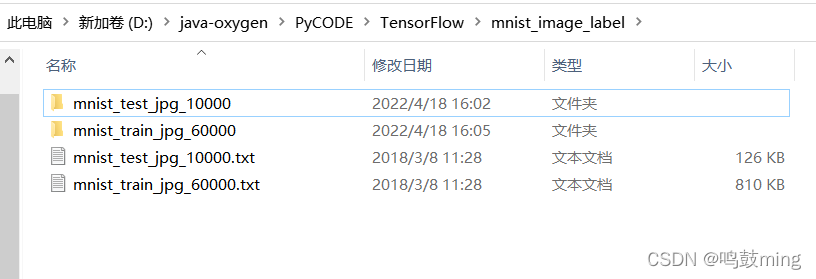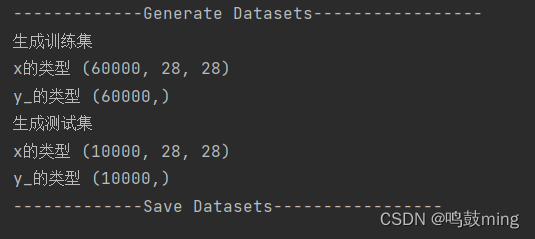1.数据文件介绍
数据集下载:https://download.csdn.net/download/qq_41865229/85254826
训练集60000张数字图片, 测试集10000张图片.

都是黑底白字的灰度图,每张图有28行28列个像素点, 命名格式为 序号_数值


两个文本文件中, 每行分别是图片名, 标签(对应的数值)


路径参数:
train_path = './mnist_image_label/mnist_train_jpg_60000/'
train_txt = './mnist_image_label/mnist_train_jpg_60000.txt'
x_train_savepath = './mnist_image_label/mnist_x_train.npy'
y_train_savepath = './mnist_image_label/mnist_y_train.npy'
test_path = './mnist_image_label/mnist_test_jpg_10000/'
test_txt = './mnist_image_label/mnist_test_jpg_10000.txt'
x_test_savepath = './mnist_image_label/mnist_x_test.npy'
y_test_savepath = './mnist_image_label/mnist_y_test.npy'
2.生成数据集
我们就是要把图片转化为离散的数据, 也就是数组形式(特征值数组和标签数组)
#生成数据集
def generateds(path, txt):
f = open(txt, 'r') # 以只读形式打开txt文件
contents = f.readlines() # 读取文件中所有行
f.close() # 关闭txt文件
x, y_ = [], [] # 建立空列表
for content in contents: # 逐行取出
value = content.split() # 以空格分开,图片路径为value[0] , 标签为value[1] , 存入列表
img_path = path + value[0] # 拼出图片路径和文件名
img = Image.open(img_path) # 读入图片
img = np.array(img.convert('L')) # 图片变为8位宽灰度值的np.array格式
img = img / 255. # 数据归一化 (实现预处理)
x.append(img) # 归一化后的数据,贴到列表x
y_.append(value[1]) # 标签贴到列表y_
print('loading : ' + content) # 打印状态提示
x = np.array(x) # 变为np.array格式
y_ = np.array(y_) # 变为np.array格式
y_ = y_.astype(np.int64) # 变为64位整型
print("x的类型", x.shape)
print("y_的类型", y_.shape)
return x, y_ # 返回输入特征x,返回标签y_
输入训练集文件的路径生成数据集, 得到60000个28*28的特征数值的矩阵数组和 60000个标签数值的一维数组

3.存储数据集
如果每次都要读入图片文件, 然后再生成数据集数组, 就很费时间; 我们可以把生成的数据集数组存储为文件, 下次要使用就可以直接读入数据集数组文件了,比较快速.
def load_data():
#如果数据集数组文件存在, 就直接载入
if os.path.exists(x_train_savepath) and os.path.exists(y_train_savepath) and os.path.exists(
x_test_savepath) and os.path.exists(y_test_savepath):
print('-------------Load Datasets-----------------')
x_train_save = np.load(x_train_savepath)
y_train = np.load(y_train_savepath)
x_test_save = np.load(x_test_savepath)
y_test = np.load(y_test_savepath)
x_train = np.reshape(x_train_save, (len(x_train_save), 28, 28))
x_test = np.reshape(x_test_save, (len(x_test_save), 28, 28))
#否则读取图片文件生成数据集数组, 并存储为数组文件
else:
print('-------------Generate Datasets-----------------')
print("生成训练集")
x_train, y_train = generateds(train_path, train_txt)
print("生成测试集")
x_test, y_test = generateds(test_path, test_txt)
print('-------------Save Datasets-----------------')
x_train_save = np.reshape(x_train, (len(x_train), -1))
x_test_save = np.reshape(x_test, (len(x_test), -1))
np.save(x_train_savepath, x_train_save)
np.save(y_train_savepath, y_train)
np.save(x_test_savepath, x_test_save)
np.save(y_test_savepath, y_test)
return x_train, y_train, x_test, y_test
1.初始未生成数据集数组文件


2.当有已生成的数据集数组文件时, 就可以直接载入


4.使用数据集
接下来我们就可以使用数据集进行神经网络的训练了, 下面是项目完整代码
image_preprocess.py
from PIL import Image
import numpy as np
import os
train_path = './mnist_image_label/mnist_train_jpg_60000/'
train_txt = './mnist_image_label/mnist_train_jpg_60000.txt'
x_train_savepath = './mnist_image_label/mnist_x_train.npy'
y_train_savepath = './mnist_image_label/mnist_y_train.npy'
test_path = './mnist_image_label/mnist_test_jpg_10000/'
test_txt = './mnist_image_label/mnist_test_jpg_10000.txt'
x_test_savepath = './mnist_image_label/mnist_x_test.npy'
y_test_savepath = './mnist_image_label/mnist_y_test.npy'
#生成数据集
def generateds(path, txt):
f = open(txt, 'r') # 以只读形式打开txt文件
contents = f.readlines() # 读取文件中所有行
f.close() # 关闭txt文件
x, y_ = [], [] # 建立空列表
for content in contents: # 逐行取出
value = content.split() # 以空格分开,图片路径为value[0] , 标签为value[1] , 存入列表
img_path = path + value[0] # 拼出图片路径和文件名
img = Image.open(img_path) # 读入图片
img = np.array(img.convert('L')) # 图片变为8位宽灰度值的np.array格式
img = img / 255. # 数据归一化 (实现预处理)
x.append(img) # 归一化后的数据,贴到列表x
y_.append(value[1]) # 标签贴到列表y_
#print('loading : ' + content) # 打印状态提示
x = np.array(x) # 变为np.array格式
y_ = np.array(y_) # 变为np.array格式
y_ = y_.astype(np.int64) # 变为64位整型
print("x的类型", x.shape)
print("y_的类型", y_.shape)
return x, y_ # 返回输入特征x,返回标签y_
#读入数据集
def load_data():
#如果数据集数组文件存在, 就直接载入
if os.path.exists(x_train_savepath) and os.path.exists(y_train_savepath) and os.path.exists(
x_test_savepath) and os.path.exists(y_test_savepath):
print('-------------Load Datasets-----------------')
x_train_save = np.load(x_train_savepath)
y_train = np.load(y_train_savepath)
x_test_save = np.load(x_test_savepath)
y_test = np.load(y_test_savepath)
x_train = np.reshape(x_train_save, (len(x_train_save), 28, 28))
x_test = np.reshape(x_test_save, (len(x_test_save), 28, 28))
#否则读取图片文件生成数据集数组, 并存储为数组文件
else:
print('-------------Generate Datasets-----------------')
print("生成训练集")
x_train, y_train = generateds(train_path, train_txt)
print("生成测试集")
x_test, y_test = generateds(test_path, test_txt)
print('-------------Save Datasets-----------------')
x_train_save = np.reshape(x_train, (len(x_train), -1))
x_test_save = np.reshape(x_test, (len(x_test), -1))
np.save(x_train_savepath, x_train_save)
np.save(y_train_savepath, y_train)
np.save(x_test_savepath, x_test_save)
np.save(y_test_savepath, y_test)
return x_train, y_train, x_test, y_test
image_identification_train.py
import image_preprocess
import tensorflow as tf
#载入数据集
x_train, y_train, x_test, y_test = image_preprocess.load_data()
model = tf.keras.models.Sequential([
tf.keras.layers.Flatten(),
tf.keras.layers.Dense(128, activation='relu'),
tf.keras.layers.Dense(10, activation='softmax')
])
model.compile(optimizer='adam',
loss=tf.keras.losses.SparseCategoricalCrossentropy(from_logits=False),
metrics=['sparse_categorical_accuracy'])
model.fit(x_train, y_train, batch_size=32, epochs=5, validation_data=(x_test, y_test), validation_freq=1)
model.summary()
运行结果

5.数据增强(增大数据量)
数据增强(Data Augmentation):是指对图片进行随机的旋转、翻转、裁剪、随机设置图片的亮度和对比度以及对数据进行标准化(数据的均值为0,方差为1)。通过这些操作,我们可以获得更多的图片样本,原来的一张图片可以变为多张图片,扩大了样本容量,对于提高模型的准确率和提升模型的泛化能力非常有帮助,在进行数据增强的同时也会需要消耗大量的系统资源。

引入数据增强操作后的代码
image_identification_train.py
import image_preprocess
import tensorflow as tf
from tensorflow.keras.preprocessing.image import ImageDataGenerator
#载入数据集
x_train, y_train, x_test, y_test = image_preprocess.load_data()
x_train = x_train.reshape(x_train.shape[0], 28, 28, 1) # 给数据增加一个维度,从(60000, 28, 28)reshape为(60000, 28, 28, 1)
image_gen_train = ImageDataGenerator(
rescale=1. / 1., # 如为图像,分母为255时,可归至0~1
rotation_range=45, # 随机45度旋转
width_shift_range=.15, # 宽度偏移
height_shift_range=.15, # 高度偏移
horizontal_flip=False, # 水平翻转
zoom_range=0.5 # 将图像随机缩放阈量50%
)
image_gen_train.fit(x_train) #把x_train送入数据增强操作
model = tf.keras.models.Sequential([
tf.keras.layers.Flatten(),
tf.keras.layers.Dense(128, activation='relu'),
tf.keras.layers.Dense(10, activation='softmax')
])
model.compile(optimizer='adam',
loss=tf.keras.losses.SparseCategoricalCrossentropy(from_logits=False),
metrics=['sparse_categorical_accuracy'])
#以flow形式, 按照batch打包后送入
model.fit(image_gen_train.flow(x_train, y_train, batch_size=32), epochs=5, validation_data=(x_test, y_test),
validation_freq=1)
model.summary()
运行结果






















 1万+
1万+











 被折叠的 条评论
为什么被折叠?
被折叠的 条评论
为什么被折叠?








